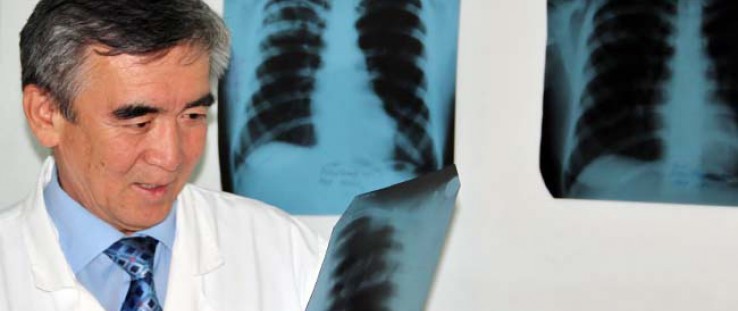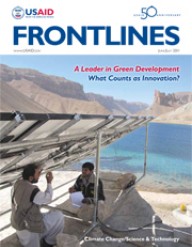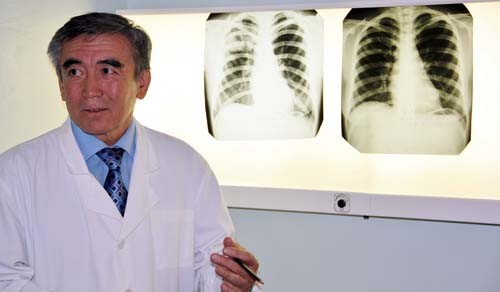 Dr. Shakimurat Ismoilov inspects a patient’s X-ray for signs of damage from a delayed MDR-TB diagnosis.
USAID
Dr. Shakimurat Ismoilov inspects a patient’s X-ray for signs of damage from a delayed MDR-TB diagnosis.
USAID
 Dr. Shakimurat Ismoilov inspects a patient’s X-ray for signs of damage from a delayed MDR-TB diagnosis.
USAID
Dr. Shakimurat Ismoilov inspects a patient’s X-ray for signs of damage from a delayed MDR-TB diagnosis.
USAID
In his office in Kazakhstan’s National Tuberculosis Institute, Dr. Shakimurat Ismoilov is quick to recall his latest encounter with multi-drug resistant tuberculosis (MDR-TB)—the country’s fastest growing and most dangerous epidemic.
“Just this morning, I examined two patients who had MDR-TB for three years and didn’t know it. They infected their children and other relatives. MDR-TB is just not easy to diagnose, and the test isn’t fast. These patients didn’t have many symptoms, and initial TB tests were negative.” Unfortunately, Dr. Ismoilov, the chief MDR-TB physician in his facility, can easily think of many similar patient stories.
“Another patient of mine first noticed symptoms in March 2010, but she wasn’t referred for a TB diagnosis by a doctor until August. Then, it wasn’t until November that we were able to diagnose her with MDR-TB, and she finally went on MDR-TB treatment in January. If she had been diagnosed earlier, she might not have developed these huge cavities in her lungs.”
Dr. Ismoilov holds up this patient’s X-rays to show the ravages of tuberculosis: the large holes grow larger with each successive X-ray, taken in the months leading up to and after her diagnosis.
A Growing and Dangerous Epidemic
Tuberculosis is an airborne contagious disease: when someone with an active infection coughs, sneezes, talks, or spits, tiny TB bacteria, called bacilli, are released into the air and can be inhaled by others. While anti-TB drugs have been successfully used to treat and cure TB for the past 50 years, roughly 1.8 million people still die annually from the disease, many of whom are between the ages of 15 and 45, the most economically productive age group.
Effective TB control requires that patients who are infected with the disease take their medication regularly and finish their treatment, which takes between six to eight months, in order to prevent drug resistance. In the past few decades, resistant and difficult-to-treat strains of TB have emerged in different parts of the world, but perhaps nowhere like in the former Soviet republics. MDR-TB treatment takes an average of two years to treat.
In the 1990s, the breakdown of Central Asian health care systems after the collapse of the Soviet Union created gaps in screening and treatment of the disease, which led to growing cases of TB and its drug resistant form. The economic and social turmoil of the time further complicated efforts to adopt an effective strategy to tackle the growing pandemic.
Today, 20 percent of the global MDR-TB burden is in the World Health Organization (WHO) European Region, which has 15 of the 27 high-burden MDR-TB countries in the world, including the five Central Asian Republics. In the region, less than a third of the estimated cases are being notified because of the lack of diagnostic capacity.
Fast Diagnosis: The Quick Fix?
Although TB cases, and specifically, cases of multi-resistant strains, are rising in Central Asia, one of the easiest ways to stem the spread of the disease is through faster diagnosis. In the region, USAID and partner organizations are working together to introduce one of the latest technological advances in TB diagnostics: GeneXpert.
This new technology, which is compact and easy to use, is able to rapidly and accurately test for TB, including strains of TB that are resistant to the most effective anti-TB drug, rifampicin. No advanced training or sophisticated laboratory infrastructure is required to use it, and perhaps most importantly, it is able to deliver results in less than 99 minutes. Patients can be diagnosed while they wait, and proper treatment can be started earlier, which could dramatically change case detection and successful treatment for many people.
In December 2010, WHO held an emergency meeting to develop recommendations on this rapid diagnostic. USAID has been involved in the development of technical guidance, as well as the plans for scale-up and introduction in several priority countries.
Decaying Detection Methods
Ten years ago, TB was primarily diagnosed through X-ray screening and clinical examination. This tool, while needed, should not be the primary method for TB diagnosis because it is not a specific indicator of TB infection.
In 1997, USAID and the Kazakhstan Ministry of Health provided new equipment to health-care facilities across the country to strengthen a diagnostic method called sputum microscopy. In existence since the late 1800s, sputum microscopy works by using a microscope to look for TB bacilli in a patient’s sputum. While preferable to X-ray screening as a priority screening method, sputum microscopy requires trained laboratory staff and proper guidelines, takes a day to produce results, and is not very sensitive. This simple method also does not identify drug-resistant strains of TB. For that, the patient’s sputum must be further tested, which can take months.
The time lag between testing and diagnosis is a major contributor to the growing MDR-TB epidemic. In spring 2010, Zhenya M.*, an IT specialist in his early 20s, started to feel ill. He tried to treat himself at home before finally deciding to see a doctor. The doctor at his local primary health care clinic took an X-ray of Zhenya’s chest and then referred him to the TB hospital for further testing.
At the hospital, his sputum tested positive for TB, and he was sent to the section of the hospital for new TB patients. Over the following three months, further testing showed that the strain of TB that Zhenya had was not resistant to the main anti-TB drugs. But after nearly six months of treatment, he was still not feeling any better. At that time tests confirmed what everyone suspected: Zhenya’s TB had become resistant to the treatment. Nearly nine months after he began to feel sick, Zhenya was finally placed on an effective drug regime.
While he is feeling better now, Zhenya was forced to quit his job because of his prolonged absence and is still in the TB hospital receiving treatment. During his time in the hospital, it is very likely that Zhenya contracted MDR-TB from a fellow patient who was waiting for his or her results. Unfortunately, this situation is all too common, says Dr. Alma Akbayeva, deputy chief doctor of the regional TB hospital. “Twenty percent of all new cases in my hospital are MDR-TB, and the slowness of MDR-TB diagnosis is a problem. If we could detect MDR-TB sooner, we could reduce the transmission of the disease.”
A New Weapon in the TB War
Since 1998, USAID has partnered with WHO, the World Bank, the STOP TB Partnership, the Global Fund, and other global TB control initiatives to provide technical assistance, strengthen local capacity, and introduce innovative yet practical solutions to effectively prevent the spread of TB and MDR-TB.
In December 2010, when WHO issued a policy statement and roadmap for roll-out of GeneXpert, USAID Administrator Rajiv Shah welcomed the news. “Rapid diagnosis … is critical to the early detection and treatment of TB …. USAID stands ready to support the roll-out of this new technology, including the advancement of sound international policy, training, and impact monitoring.”
Quick diagnosis through GeneXpert—which was developed by the American company Cepheid—also significantly lowers the chances that a patient will contract MDR-TB in the hospital, like Zhenya probably did.
“USAID believes that hospital transmission is a major mechanism for the spread of MDR-TB in the region. The use of GeneXpert will contribute to early detection of rifampicin-resistant TB, as well as timely separation and appropriate treatment of MDR-TB patients,” said Dr. Kairat Davletov, a USAID health specialist.
USAID’s effort to implement this technology is part of a multi-pronged strategy to counter the growing swell of MDR-TB cases in Central Asia. With the help of GeneXpert, it is hoped that far more people will be diagnosed with MDR-TB in a shorter period of time, and fewer individuals infected with MDR-TB will have to risk losing their health, time, and possibly their lives while waiting for a test result.
No More Time Lost
As USAID works with local and international partners to prepare for the introduction of GeneXpert in Kazakhstan and other Central Asian countries in the future, word is out that a new technology exists that can rapidly detect rifampicin-resistant TB, a proxy for MDR-TB. For some patients already infected with MDR-TB, the news is bittersweet.
“My doctor recently told me that there is a new diagnostic method to identify drug-resistance in less than two hours! If this tool had existed in 2010, I wouldn’t have lost so much time because I would have started treatment much earlier,” says Erik T. from east Kazakhstan, a patient with a drug-resistant strain of the disease.
Implementation of this new technology could not have come at a better time for patients and doctors alike. “We’re clinicians. We recognize the problem, and we see that there are more and more MDR-TB patients in our hospital every year. It would be invaluable to have GeneXpert here,” says Dr. Akbayeva.
*Last names of patients have been withheld to protect their privacy.











Comment
Make a general inquiry or suggest an improvement.